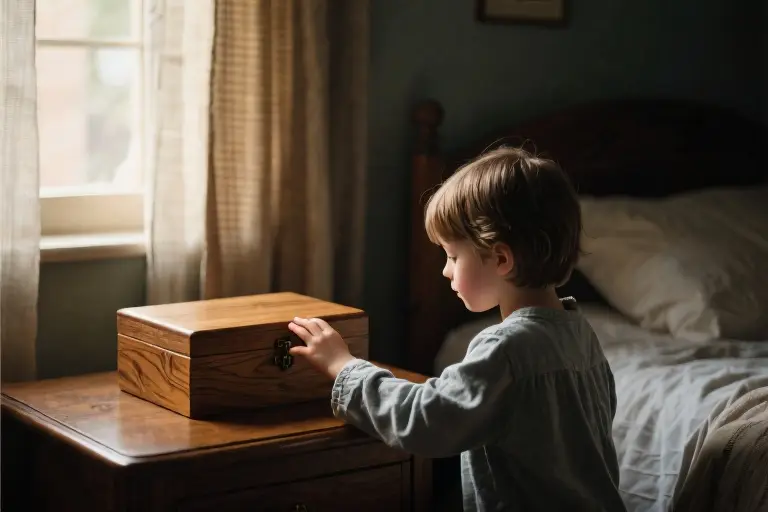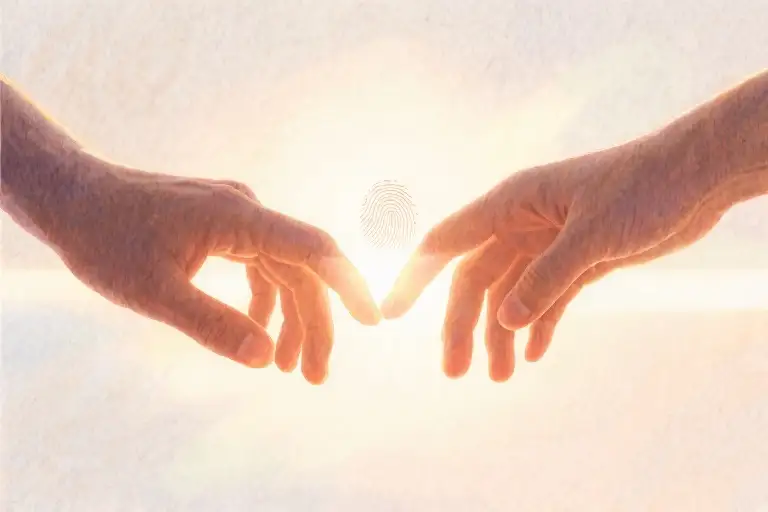The river doesn’t stop flowing when it reaches the sea. It becomes the sea. Love moves like that too – constantly, inevitably, following gravity’s pull toward someone. You see it in the way hands find each other across restaurant tables without looking, in coffee mugs refilled before being empty, in shared silences that feel warmer than most conversations. These ordinary moments carry extraordinary currents.
But rivers sometimes flood their banks. What happens to all that water when the landscape changes? When the person who received your love – who was your love’s destination – suddenly isn’t there anymore? The coffee cools in the mug you still can’t bring yourself to wash. Their side of the closet stays full. Their toothbrush remains in the holder, bristles hardening with each passing day.
Love persists like water in soil after rain – you can’t see it, but everything is still damp with it. Grief isn’t the absence of love; it’s love continuing its journey without its intended recipient. The texts you still compose but never send. The jokes you hear and instinctively turn to share with empty air. The recipes you cook too large because muscle memory hasn’t adjusted to cooking for one.
This leftover love has weight. You feel it in your sternum when waking, in your throat when trying to speak their name, in your palms when handling objects they once touched. Unlike the flowing river of shared love, this love pools inside you with nowhere to go. You try channeling it into letters never mailed, into donations made in their name, into conversations with their photograph. Nothing quite fits.
Yet the river’s nature is to keep moving. However slowly, however painfully, love finds new paths. You begin noticing their laughter in children’s voices at playgrounds. Their wisdom comes through a stranger’s kind words. Their memory lives in stories you tell nervous newcomers at support groups. The love changes form, but doesn’t diminish.
What we call grief is simply love’s persistence beyond physical presence. It’s the heart’s way of continuing its most important work – connecting, remembering, honoring – even when the other end of the connection seems severed. The ache isn’t emptiness; it’s fullness in a container that’s changed shape. Proof that what was built between you was real enough to leave this lasting impression.
The river eventually reaches the ocean, but scientists say water molecules may spend centuries in deep currents before resurfacing. Perhaps love moves like that too – circulating through unseen channels until it finds its way back to where it belongs.
The Direction of Love’s Current
Love moves with the insistence of a river carving its path through stone. It carries within it the same quiet determination, the same gravitational pull toward something beyond itself. This isn’t the abstract love of greeting cards or movie endings, but the living kind that shows up in the mundane architecture of our days.
Morning texts arrive before the alarm finishes its first ring. Hands reach across restaurant tables not for dramatic gestures, but to trace the familiar topography of knuckles and scars. Someone peels oranges in the afternoon light, sectioning them carefully because they remember how you dislike the white pith clinging to the fruit. These aren’t grand declarations, but the daily bread of love – small, nourishing, and necessary.
Like electricity seeking ground, love flows toward embodiment. It wants to become action, to transform from potential energy into the kinetic reality of a shared life. The peculiar magic lies in how ordinary these conduits appear – a saved seat at the cinema, coffee mugs placed just so on the counter, the way someone’s laugh becomes your favorite song without a single note being sung.
This current carries directionality, though we rarely notice its compass until the landscape changes. Love knows where to pour itself – into the spaces between someone’s sentences, into the hollow of their collarbone at 3am, into the silent understanding that survives even heated arguments. It maps itself onto another person with terrifying precision, learning the coordinates of their joy and sorrow until navigation becomes instinct.
Yet for all its fluid grace, love leaves marks. The riverbed remembers every curve of water that passed through. We carry these impressions long after the current changes course – in muscle memory that still turns toward an empty side of the bed, in hands that reach for a phone no longer set to receive our messages. The direction remains, even when the destination has vanished.
Perhaps this explains why certain smells still catch in our throats years later, why particular songs make us pull over to the shoulder of the road. The love didn’t disappear when the person did. It simply continues flowing along its original trajectory, like light from a star that burned out centuries ago, still traveling through space because no one told it to stop.
The Love That Remains
The body remembers what the mind tries to forget. You swallow coffee the wrong way and suddenly you’re coughing with tears in your eyes—not from the burning in your throat, but because they always warned you about drinking too fast. Your hands develop their own memory, trembling when you touch the spine of a book they once read, fingers tracing the indentations their fingertips left behind.
This is how love lingers after loss. Not as some abstract concept, but as physical weight—a lump beneath your sternum like swallowed words, a heaviness in your pockets where unused hands go to hide. You catch yourself holding objects longer than necessary: a hairbrush still tangled with strands you can’t bring yourself to clean, a jacket sleeve that smells faintly of their shampoo weeks later.
We try to redirect this stranded love. You scribble half-finished poems on napkins, lines breaking mid-metaphor when you realize there’s no one left who’d understand your references. You whisper secrets to thunderstorms, hoping the rain might carry them somewhere. At dusk, you stare at the same patch of sky they once called “the exact color of happiness”, as if cosmic forces could somehow translate your gaze into a message.
None of it works, not really. The love stays. It pools in the hollow of your collarbone when you wake alone. It hums in your teeth when you bite back their name at inappropriate moments—during work meetings, while ordering takeout, mid-conversation with someone new who’ll never know about this fracture in your voice.
What no one prepares you for is how love becomes a series of absences. The empty side of the bed stops feeling empty; it becomes an invisible presence, a shape you learn to navigate around like furniture in a dark room. Their missing becomes its own kind of existing. You stop reaching for a second coffee mug in the morning, but your hand still hesitates near the cabinet.
This is grief’s quiet truth: love doesn’t vanish when someone dies. It loses its fluency. The grammar of your affection falters—all those verbs with no object, sentences trailing off into silence. You’re left speaking a language only the departed would understand, full of inside jokes that now land like unanswered prayers.
Yet there’s a sacredness to this untranslatable love. In the way you still set out two plates sometimes, just to remember how it felt to share a meal. How you hum their favorite song off-key in the shower, keeping the melody alive in the only way left to you. These aren’t acts of denial, but of preservation—tending to embers that still glow beneath the ashes.
The world moves on, but your love remains. Not as a wound, but as a compass pointing toward what once was true. And perhaps that’s enough: to carry this unspent love like a river carries moonlight—not trying to possess it, just letting it flow through you, onward and away, toward whatever comes after goodbye.
The Anatomy of Grief: When Love Has No Landing Place
Grief settles in the body like weather patterns – sometimes a slow drizzle you learn to ignore, other times a hurricane that uproots everything in its path. It’s not the absence of love, but love’s stubborn persistence in a world where its object has vanished. That text message you’ll never send, that inside joke now trapped in your throat, that half-turn to share a thought with someone who isn’t there – this is love continuing its current with nowhere to flow.
Most days it lives as background static. You function through it like carrying a cup too full, careful not to spill. The grocery store cashier asks normal questions while your fingers remember how their hands always warmed yours in the freezer aisle. You drive home past the diner where they always ordered pancakes at midnight, and for three blocks your vision blurs in a way that has nothing to do with streetlights. These moments don’t paralyze – they simply remind you that love didn’t get the memo about endings.
Then come the squall days. A song plays in a coffee shop and suddenly you’re back in their passenger seat with the windows down. You open a book to find their margin notes in pencil, that looping handwriting turning the page into a landmine. Their shampoo bottle falls in your shower, and for twenty minutes you sit on wet tiles smelling what’s left of them. The body remembers what the mind tries to compartmentalize – the way grief isn’t one large boulder but countless sharp pebbles in your shoes.
What we call mourning is really love’s improvisation. You develop rituals without meaning to – leaving their favorite mug in the cabinet instead of washing it, keeping an expired coupon they clipped in your wallet. You scan crowds for their posture, their laugh, the way they used to push hair behind their ears. When strangers mention their name or birthday appears as a notification, it feels like the universe whispering secrets about where they might be.
This isn’t pathology. It’s love rerouting, finding new capillaries when its main arteries are gone. The trembling hands when you touch their belongings, the dreams where they appear without explanation, the way you still say ‘we’ after months of ‘I’ – these aren’t failures to move on. They’re proof that love refuses to be tidy or convenient, that it outlasts even the laws of physics.
Perhaps grief persists because love was never ours to begin with. We channeled it, directed it, but like water finding cracks in stone, it follows its own logic. The ache isn’t emptiness – it’s the shape of where love used to live, the negative space that still pulls like tide. Some days you’ll resent its weight. Other days you’ll press that pain like a bruise just to feel connected. Both are valid. Both are love.
Finding New Riverbeds for Love
The love that remains after loss doesn’t evaporate – it simply seeks new channels. Like water finding cracks in stone, it flows into unexpected places. You might catch yourself searching for their smile in passing strangers, or hearing their laugh in crowded rooms. These moments aren’t delusions, but the natural movement of love adapting to its new reality.
Grief reshapes how we experience connection. That morning coffee ritual now performed alone still carries their memory in the steam rising from the cup. The songs they loved still play, but now they’re duets between the living and the gone. Love learns to exist in these liminal spaces – in the pause between heartbeats, in the hesitation before speaking to an empty room.
Some try to dam this flow, to contain what cannot be contained. But love persists. It surfaces in dreams where conversations continue uninterrupted. It appears in coincidences too precise to dismiss – their favorite flower blooming unexpectedly, a shared joke overheard at the wrong moment. These aren’t merely memories, but evidence of love’s enduring presence.
The ache serves as both wound and compass. That tightness in your chest when encountering their handwriting isn’t just pain – it’s love’s new vocabulary. The trembling hands holding their old sweater aren’t weak – they’re translating absence into a different kind of touch. What we call grief is simply love’s new dialect, one we learn through stumbles and silences.
Practical expressions emerge organically. Setting an extra place at holidays. Continuing traditions they began. Speaking their name aloud when sharing stories. These acts aren’t clinging to ghosts, but acknowledging that love’s current continues beyond physical presence. The relationship hasn’t ended – it has transformed.
There’s courage in allowing love to change form. To recognize that helping others with the compassion they taught you isn’t replacement, but continuation. That laughing at their favorite joke with new people isn’t betrayal, but testimony. The love survives not despite these transformations, but through them.
Perhaps this is love’s final lesson – that it cannot be contained or redirected by will alone. Like water, it finds its own level. Our task isn’t to control its flow, but to recognize its new paths, to honor its persistence in whatever form it takes. The current still moves, still reaches, still connects – just differently now.
Where Love Lands When There’s No Shore
That love doesn’t evaporate when someone dies. It pools in the quiet corners of your life like rainwater collecting in the cupped leaves of a plant after a storm. You find it in the way your fingers still reach for your phone to share small things with them before remembering. In how you catch yourself buying their favorite tea at the grocery store, the box halfway into your cart before the reality hits. These aren’t mistakes of habit – they’re love continuing its journey without its intended recipient.
The strange alchemy of grief transforms love’s outward motion into something more circular. Where it once flowed toward another person, it now spirals inward, carving new channels through you. Some days it feels like erosion, wearing you down with its constant motion. Other times it builds something unexpected – patience where there was impatience, tenderness where there was roughness, an understanding of loss that lets you sit quietly with others in theirs.
We keep looking for landing places. In dreams where they appear so vividly we wake expecting to find indents on the pillows. In coincidences that feel too precise to be random – their birthday appearing as a total on a receipt, their song playing when you enter an empty cafe. These moments aren’t visitations but evidence of how thoroughly love has rewired us to notice what connects us to them still.
What no one prepares you for is how love persists in the body long after the mind accepts the loss. The way your hands still know the exact pressure they liked on their shoulders during headaches. How your nose recognizes their shampoo on a stranger passing by. The muscle memory of love outlasts the opportunity to use it, leaving you with this surplus of care that has nowhere to go.
So we improvise new destinations. We love what they loved – their causes, their people, their unfinished projects. We speak to them in empty rooms and crowded streets, trusting some particle of our words will find them. We become archivists of their existence, preserving the way they laughed at bad jokes or salted food before tasting it. In loving their memory, we keep some part of them animated in the world.
Perhaps this is what eternity looks like – not some frozen forever, but love’s persistent ripples moving through time. The way a stone dropped in a pond sends waves to shores the thrower never sees. Our grief isn’t the absence of love but its changed form, like water becoming mist. It rises instead of flows, surrounds instead of reaches, but remains essentially what it always was.
Where does the love go? Nowhere. Everywhere. Into the quiet acts no one witnesses. Into the kindnesses we extend because they would have. Into the stories we tell that keep their voice alive in the telling. The love doesn’t stop – it simply changes direction, like a river meeting the sea and becoming part of something larger.





